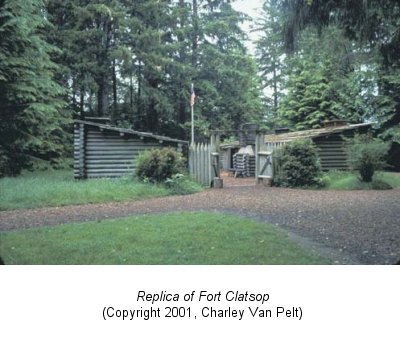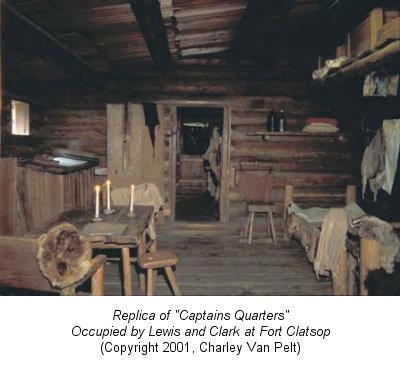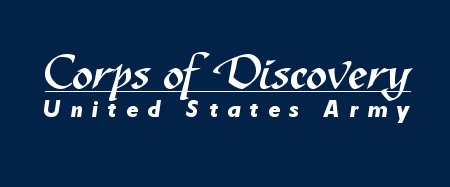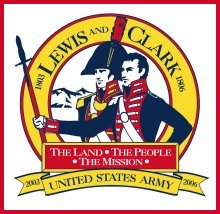The U.S. Army and the Lewis & Clark
Expedition
Part 7: Fort Clatsop and the Return Trek
Life at Fort Clatsop was depressing. Of the 112 (some say 102) days
the expedition was there, it rained every day except twelve, and only
half of those were clear days. Most of the men suffered from being constantly
wet and cold, and their clothing was rotting off their backs. Making
salt was a vital diversion, but boiling ocean water was a slow and tedious
process. After two months the operation

produced only one bushel of salt. Without salt, preserving food in
the wet and humid weather was a serious problem. To make matters worse,
hunting parties had a difficult time finding enough palatable food for
the expedition. Despite these challenges, Lewis and Clark kept everyone
busy, including themselves. Lewis spent much of his time writing in
his journal on botanical, ethnological, meteorological, and zoological
topics, while Clark completed the first map ever made of the land between
North Dakota and the Pacific coast. Together they discussed what they
had seen and learned from the Indians.
After three months of constant rain, dietary problems, fleas, and boredom,
the Corps of Discovery left Fort Clatsop on 23 March 23. Concerned with
the security of the Expedition, the two captains wanted “to lose
as little time as possible” getting to the Nez Perce. They decided
to return along the same path they had come, satisfied that it was the
best possible route. Even though security was rigid, at various points
on the way up the Columbia, Lewis and Clark had to use the threat of
violence to preclude trouble with the Indians. In early May they finally
reached their old friends, the Nez Perce. Once again, the Nez Perce
demonstrated their hospitality by feeding and taking care of the Corps
of Discovery. During a two-month stay with the Nez

Perce, Lewis and Clark held councils with the tribal elders, while
their men participated in horse races and other games with young Indian
warriors. Clark also used his limited medical skills to created more
goodwill. These activities built great relations with the Indians. Indeed,
Lewis wrote the Nez Perce considered Clark their “favorite physician.”
On 10 June, the Corps of Discovery set out toward the Lolo Trail, over
the objections of the Nez Perce. The Indians had warned Lewis and Clark
that the snow was still too deep to attempt a recrossing of the Rockies.
Eager to get home, the captains ignored this sound advice and proceeded
on without Indian guides. In a week the expedition found itself enveloped
in snow twelve to fifteen feet deep. Admitting that the going was “difficult
and dangerous,” Lewis and Clark decided to turn back. “This
was the first time since we have been on this long tour,” Lewis
wrote, “that we have ever been compelled to retreat or make a retrograde
march.” Sergeant Gass agreed, and noted that most of the men were
“melancholy and disappointed.” Two weeks later, the Corps
of Discovery set out once again, this time with Indian guides. Averaging
nearly twenty-six miles a day, the expedition took just six days to
reach the eastern side of the Rockies. On 30 June, Lewis and Clark set
up camp at Travelers Rest. There, the Corps of Discovery rested for
three days before implementing the final portion of its exploration.
According to the plan Lewis and Clark had formulated at Fort Clatsop,
they split their command into four groups. Captain Lewis, Sergeant Gass,
Drouillard, and seven privates would head northeast to explore the Marias
River and hopefully meet with the Blackfeet to establish good relations
with them. At the portage camp near the Great Falls, Lewis would leave
Gass and three men to recover the cache left there. Captain Clark would
take the remainder of the expedition southeast across the Continental
Divide to the Three Forks of the Missouri. There, he would send Sergeant
Ordway, nine privates, and the cache recovered from Camp Fortunate down
the Missouri to link up with Lewis and Gass at the mouth of the Marias
River. Clark, four privates, the Charbonneau family, and York would
then descend the Yellowstone River to its juncture with the Missouri
River. Meanwhile, Sergeant Pryor and three privates would take the horses
overland to the Mandan villages and deliver a letter to the British
North West Company, seeking to bring it into an American trading system
Lewis sought to establish. Lewis and Clark would unite at the juncture
of the Missouri and Yellowstone Rivers in August.
The willingness of Lewis and Clark to divide their command in such
rugged, uncertain, and potentially dangerous country shows the high
degree of confidence they had in themselves, their noncommissioned officers,
and their troops. In addition to the physical challenges the expedition
would certainly meet, war parties of Crow, Blackfeet, Hidatsa, and other
tribes regularly roamed the countryside and threatened to destroy the
expedition piecemeal. By dividing their command in the face of uncertainty,
Lewis and Clark took a bold but acceptable risk to accomplish their
mission.
Separated for forty days, the Corps of Discovery proceeded to accomplish
nearly all its objectives. Lewis and his team successfully explored
the Marias but narrowly escaped a deadly confrontation with the Blackfeet
in which two Indians died. What had begun as a friendly meeting turned
into a tragedy. On the afternoon of 26 July, Lewis came upon several
Blackfeet, greeted them, handed out a medal, a flag, and a handkerchief,
and invited them to camp with his party. They agreed. Lewis was thrilled,
but at the same time somewhat apprehensive: the Nez Perce, the Shoshoni,
and other plains tribes had warned Lewis to avoid their traditional
enemy. At council that evening, Lewis discussed the purpose of his mission,
asked the Blackfeet about their tribe and its trading habits, and urged
them to join an American-led trade alliance. During the discussion,
Lewis noticed that the Indians possessed only two guns; the rest were
armed with bows, arrows, and tomahawks. The meeting concluded with smoking
the pipe. Nevertheless, after standing first watch, Lewis woke Reubin
Field and ordered him to observe the movements of the Blackfeet and
awaken him and the others if any Indian left the camp.
At daybreak Joseph Field was standing watch without his rifle. As the
Blackfeet crowded around the fire to warm themselves, Field realized
he had carelessly left his rifle unattended beside his sleeping brother
Reubin. Suddenly, Drouillard’s shouts awakened Lewis, who noticed
Drouillard scuffling with an Indian over a rifle. Lewis reached for
his rifle, but it was gone. He drew his pistol, looked up, and saw an
Indian running away with his rifle. At the same time, another Indian
had stealthily slipped behind Joseph Field and grabbed both his and
Reubin’s rifles. The men chased the Indians, and Lewis and Drouillard
managed to recover their rifles without incident. But when the Field
brothers caught the Indian with their rifles, a fight ensued and the
Blackfoot died of a knife wound to his heart. After recovering the weapons,
the soldiers saw the Blackfeet attempting to take their horses. Lewis
ordered the men to shoot if necessary. Running after two Blackfeet,
Lewis warned them to release the horses or he would fire. One jumped
behind a rock while the other raised his British musket toward Lewis.
Instinctively, Lewis fired, hitting the Indian in the abdomen. The Blackfoot
fell to his knees but returned fire. “Being bearheaded [sic],”
Lewis wrote, “I felt the wind of his bullet very distinctly.”
Fearing for their lives, Lewis, Drouillard, and the Field brothers began
a frantic ride southeastward to reunite with Sergeants Gass and Ordway
at the mouth of the Marias. This they accomplished on 28 July, after
riding nearly 120 miles in slightly more than twenty-four hours.
As Lewis and his party made their way from the site where they had
encountered the Blackfeet, Sergeant Ordway’s group had recovered
the cache at Camp Fortunate, proceeded down the Missouri River, and
linked up with Sergeant Gass without incident. Gass’ team had already
recovered the cache at the portage camp at the Great Falls and was awaiting
Lewis and Ordway. Meanwhile,
while Clark and his party were exploring the Yellowstone River, Pryor
could not complete his mission. On the second night out, a Crow raiding
party stole all the soldiers’ horses. Demonstrating their ingenuity,
Pryor and his men kept their cool, walked to Pompey’s Pillar (named
in honor of Sacagawea’s infant son, whom Clark nicknamed “Pomp”),
killed a buffalo for food and its hide, made two circular Mandan-type
bullboats, and floated downriver to link up with Clark on the morning
of 8 August. Four days later, Lewis and his group found Clark along
the banks of the Missouri River.
Clark was astonished to see Lewis lying in the white pirogue recovering
from a gunshot wound in the posterior, but he was relieved to learn
it was not serious. While hunting on 11 August, Private Cruzatte apparently
had mistaken Lewis for an elk. On 14 August, the Expedition reached
the Mandan villages. After a three-day visit with the Mandans, the Corps
of Discovery bit farewell to the Charbonneau family and Private Colter
(who had requested an early release so he could accompany two trappers
up the Yellowstone River) and proceeded down the Missouri River. On
1 September, Lewis and Clark held a council with some friendly Yankton
Sioux. Three days later the Corps of Discovery stopped to visit the
grave of Sergeant Floyd





